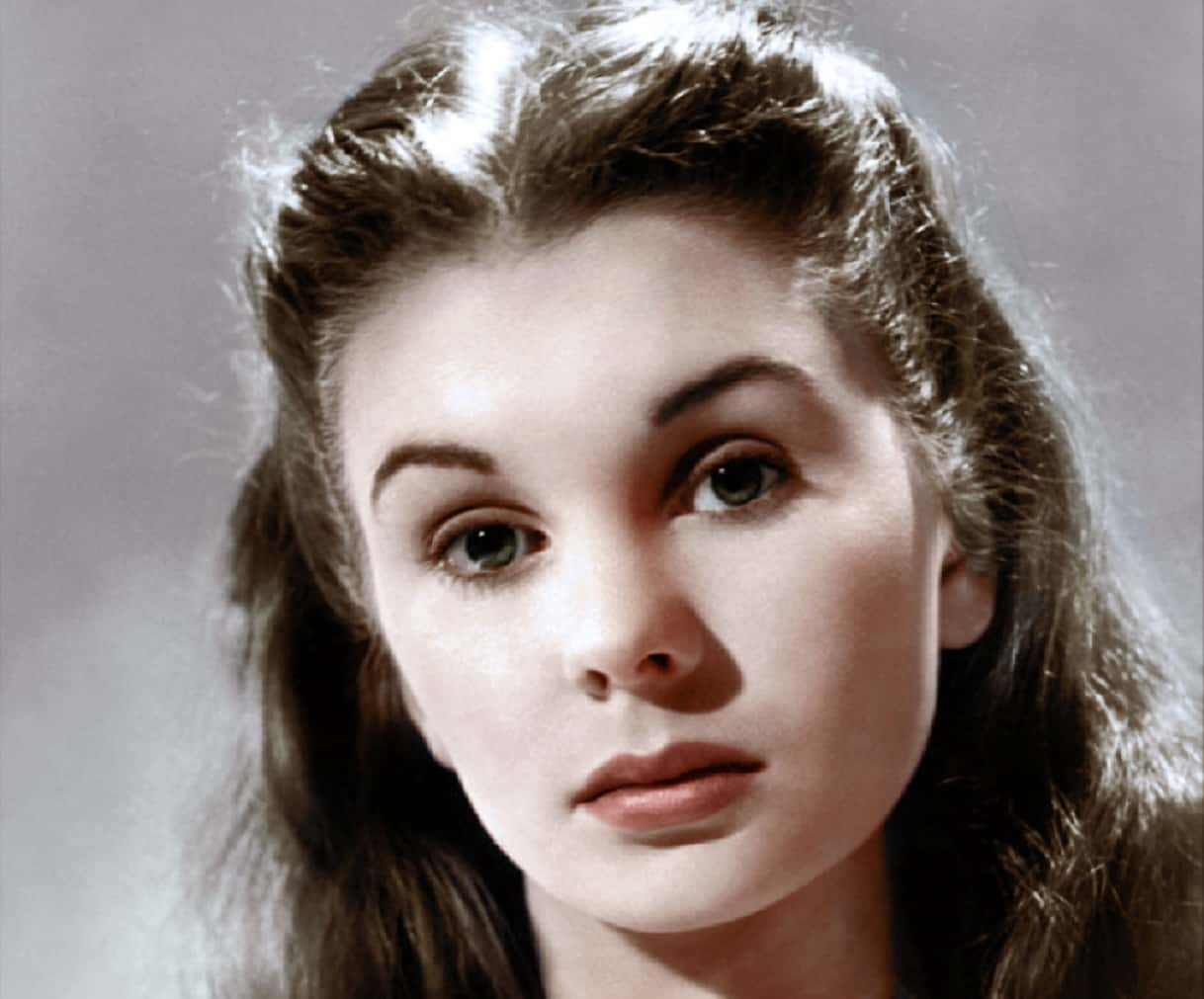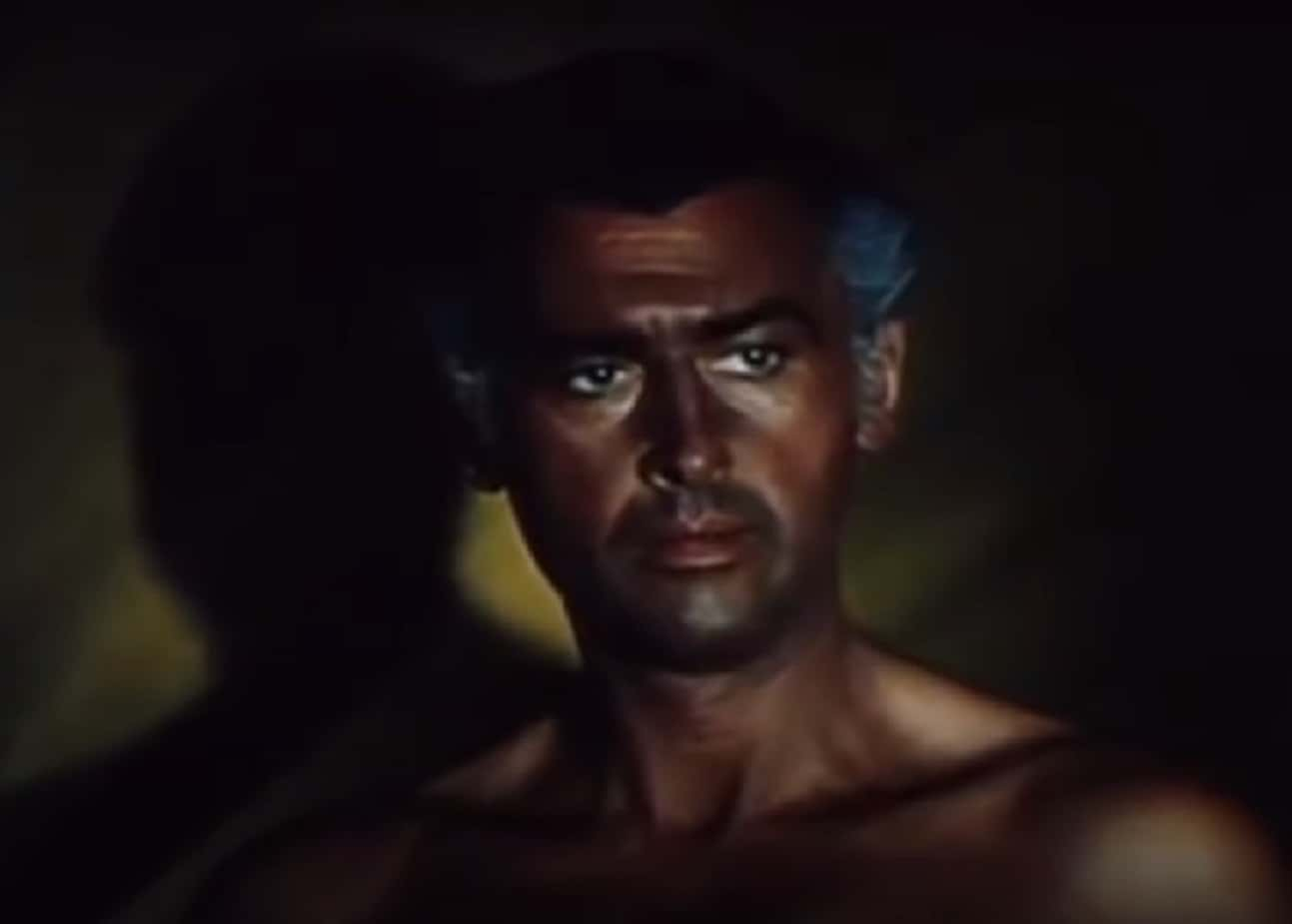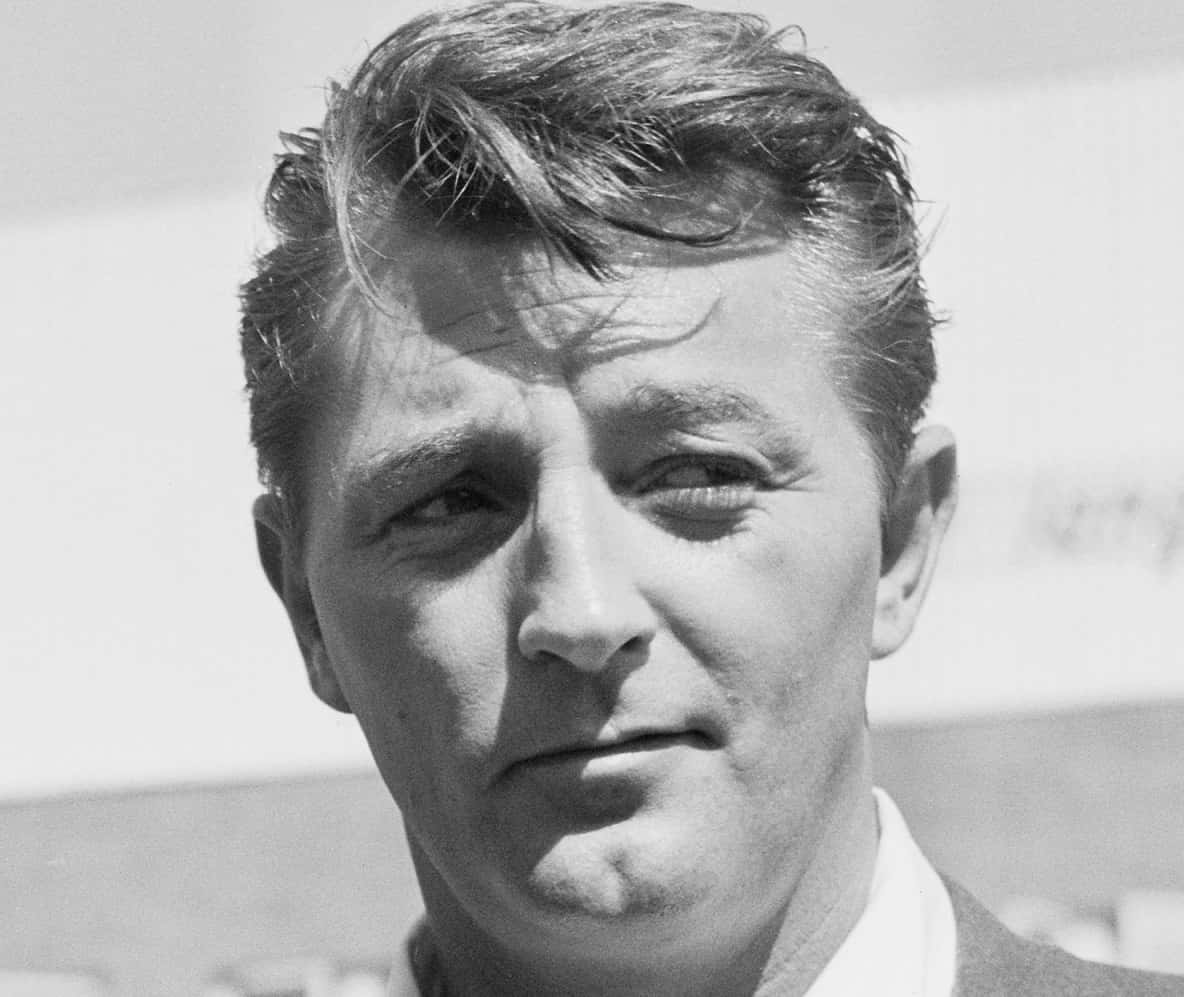Jean Merilyn Simmons was the 1950s film sensation whose stunning good looks landed her some big roles—and some even bigger trouble. The British-born beauty attracted the attention of the likes of Howard Hughes and Richard Burton, but she learned the hard way that there's a dark side to that kind of attention.
1. She Was Born In Bronze
Jean Simmons was born in January of 1929 in London, England. Her father, Charles Simmons, was the bronze medal-winning gymnast at the 1912 Summer Olympics. But from a very young age, it was obvious that Simmons was destined for gold—Oscar gold. Of course, she had a long life of ups and downs before she could even dream of fancy awards.

2. She Had Olympic Ambitions
Simmons knew that she had a knack for entertaining, having appeared on stage with her sister early in her life. But her ambitions were humble at first. She decided to follow in her father’s footsteps and dreamed of becoming an acrobatic dancer. Sadly, before Simmons was ever in sight of Olympic glory, tragedy struck.
3. She Suffered An Unexpected Loss
Unexpectedly and practically without explanation, Simmons’ father passed on. She was just 16 years old at the time and the tragic loss left her reeling. It’s not exactly clear how Simmons lost her beloved father, but one thing is clear: The unfortunate event left a permanent mark on Simmons’ heart. She wouldn’t have time to heal that wound.
4. She Made A “Guest” Appearance
Simmons continued her acrobatic dancing and buried her sorrow in her work. That’s when British film director Val Guest spotted the teenaged Simmons and knew he had found a star. Guest chose Simmons over 200 other applicants for a prominent role in the 1944 film Give Us the Moon alongside megastar Margaret Lockwood. Her life would never be the same again.
 Give us the moon (1944), Gainsborough Pictures
Give us the moon (1944), Gainsborough Pictures
5. She Was The Girl On Fire
Simmons took a shining to the camera—and it took a shining to her. Over the next couple of years, she appeared in minor roles in several films. You might say that she was catching fire. Literally. While filming a scene for 1946’s Great Expectations in which she climbs stairs holding a candle, Simmons’ apron caught fire. And so did her love life.
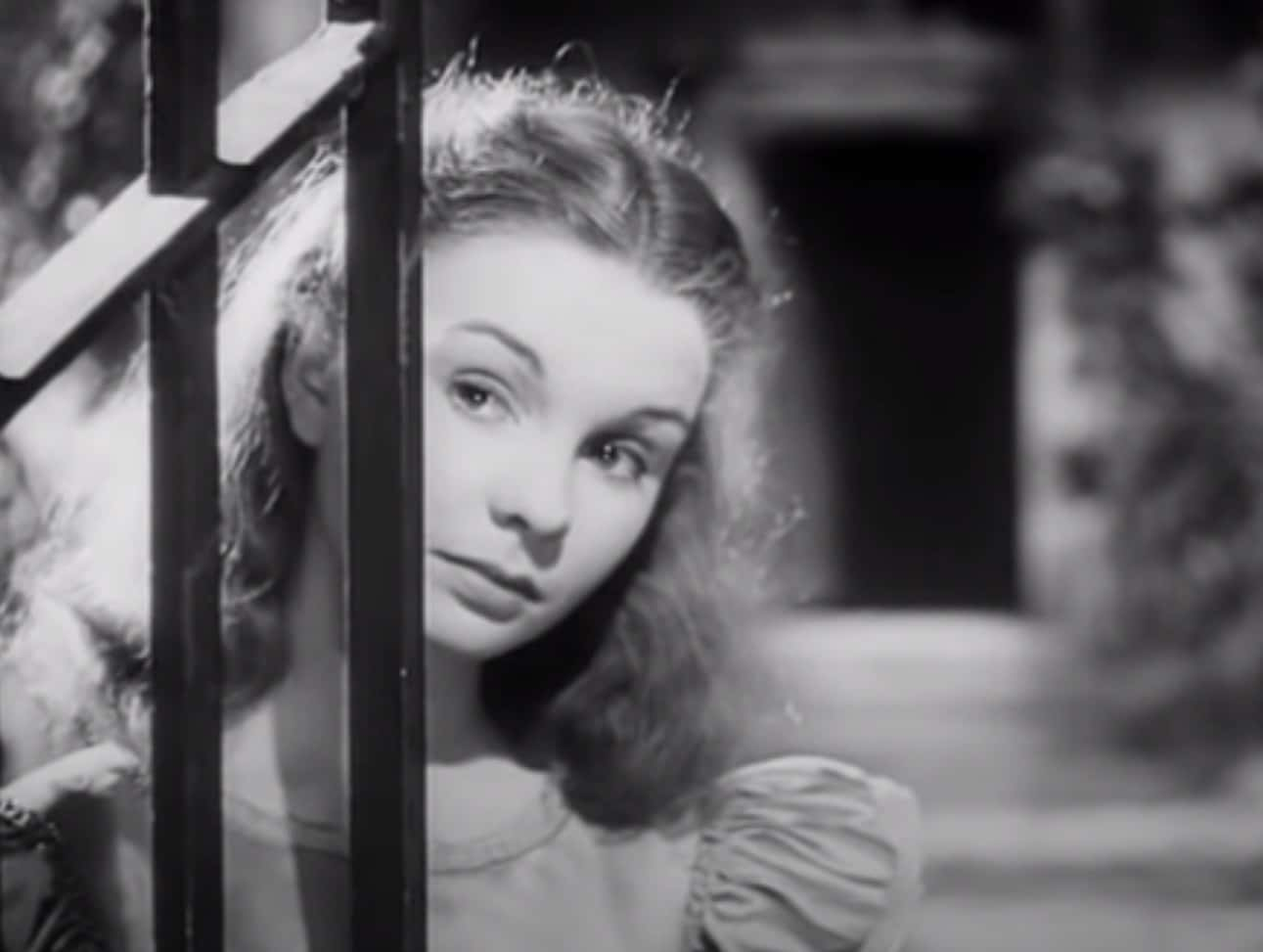 Great Expectations (1946), Cineguild
Great Expectations (1946), Cineguild
6. She Was Half Of A Power Couple
Simmons had an uncredited role in 1945’s Caesar and Cleopatra. Even though the movie was about the most famous power couple of the ancient world, Simmons was brewing a world-changing romance of her own. While on set, she met the dashing Stewart Granger, an actor 15 years her senior. But seeing as though Simmons was only 16, she and Granger remained just friends—for now. But the young starlet was officially on Granger's radar...
7. She Had Great Expectations
Simmons first thought that acting was just a fun way to make quick money. She recalled, “I thought acting was just a lark, meeting all those exciting movie stars, and getting £5 a day which was lovely because we needed the money". But her breakout performance in Great Expectations left her with…well, great expectations. Suddenly, she wanted so much more.
 Great Expectations (1946), Cineguild
Great Expectations (1946), Cineguild
8. She Outgrew Her Hamlet
Simmons beat out over 1,600 other would-be starlets for the opportunity to play Kanchi in 1947’s Black Narcissus. But that was just a stepping stone to her real breakout as Ophelia alongside Laurence Olivier in 1948’s Hamlet. No longer just a bit player on screen, the role netted Simmons her first Oscar nomination. But not everyone was impressed with the young British beauty.
9. She Was Shaking Like A Dog
Years later, Simmons recalled an incident on the set of Hamlet that left her co-star, Laurence Olivier, shaking his head. “My first day,” Simmons said, “I was in a freezing cold river trying to sing which I didn't do very well […] I couldn't sing the ditty I was supposed to sing […] and [Olivier] was quite cross…”
10. She Should Have Taken Lessons
Despite the fact that Simmons managed to nab an Oscar nomination for her portrayal of Ophelia, Olivier thought she could use some pointers. Luckily, she had Laurence Olivier, one of the greatest actors in history, to ask for advice. The veteran actor suggested that the young beauty stop relying on her looks and take whatever roles she could get at London's Old Vic Theatre. It was good advice—but Simmons didn't follow it.
Her producers had other plans: international fame.
11. She Was Almost Voted Off The Island
Simmons went on to star in the 1949 box office smash hit, The Blue Lagoon—a film that she nearly never made. The studio planned to film The Blue Lagoon in Fiji which, at the time, was considering banning people under the age of 19 from the island. Simmons was just 18. She ended up getting in, but she'd soon wish she hadn't. She barely made it out of that trip alive.
 The Blue Lagoon (1949), General Film Distributors
The Blue Lagoon (1949), General Film Distributors
12. Her Career Capsized
Simmons and her The Blue Lagoon co-star, Donald Houston, were traveling in a car together. The details are scarce but Houston, the driver, somehow lost control of the car—and this was no minor fender bender. He was driving fast enough that the car violently rolled before coming to a stop. Fortunately, both Simmons and Houston managed to escape the wreck without any injury and filming of The Blue Lagoon continued without incident.
The movie made Simmons an even bigger star—and soon, she was ready to cross paths with a face from her past.
 The Blue Lagoon (1949), General Film Distributors
The Blue Lagoon (1949), General Film Distributors
13. She Married Up—In Age
Simmons next starred in the 1949 comedy Adam and Evelyne. Her co-star was her old (and we mean that literally) friend Stewart Granger. Now that she was a 21-year-old adult, Simmons and Granger began the romance that they had been pining for since Caesar and Cleopatra. Just a year later, the pair married—but there were storm clouds on the horizon.
14. She Led A Quiet Life Until…
Simmons and Granger managed to keep the details of their romantic life out of the tabloids. But that just meant that there was more room for speculation. In an attempt to promote the 1950 film So Long at the Fair, the studio planned on pretending that Simmons was, in fact, romantically involved with her co-star, Dirk Bogarde. There was just one small problem.
15. She Almost Had An Affair
The announcement of Simmons and Granger’s pending nuptials came out before So Long at the Fair. Alleging a romance between Simmons and Bogarde would have caused a scandal that was bad for the box office. For Bogarde, there was also the danger of attracting too much attention—he was a closeted gay man. In the end, the studio dropped the idea…and Simmons got caught in the crossfire.
The studio originally planned to make three movies with her, but after the marketing fiasco, they dropped her after just one.
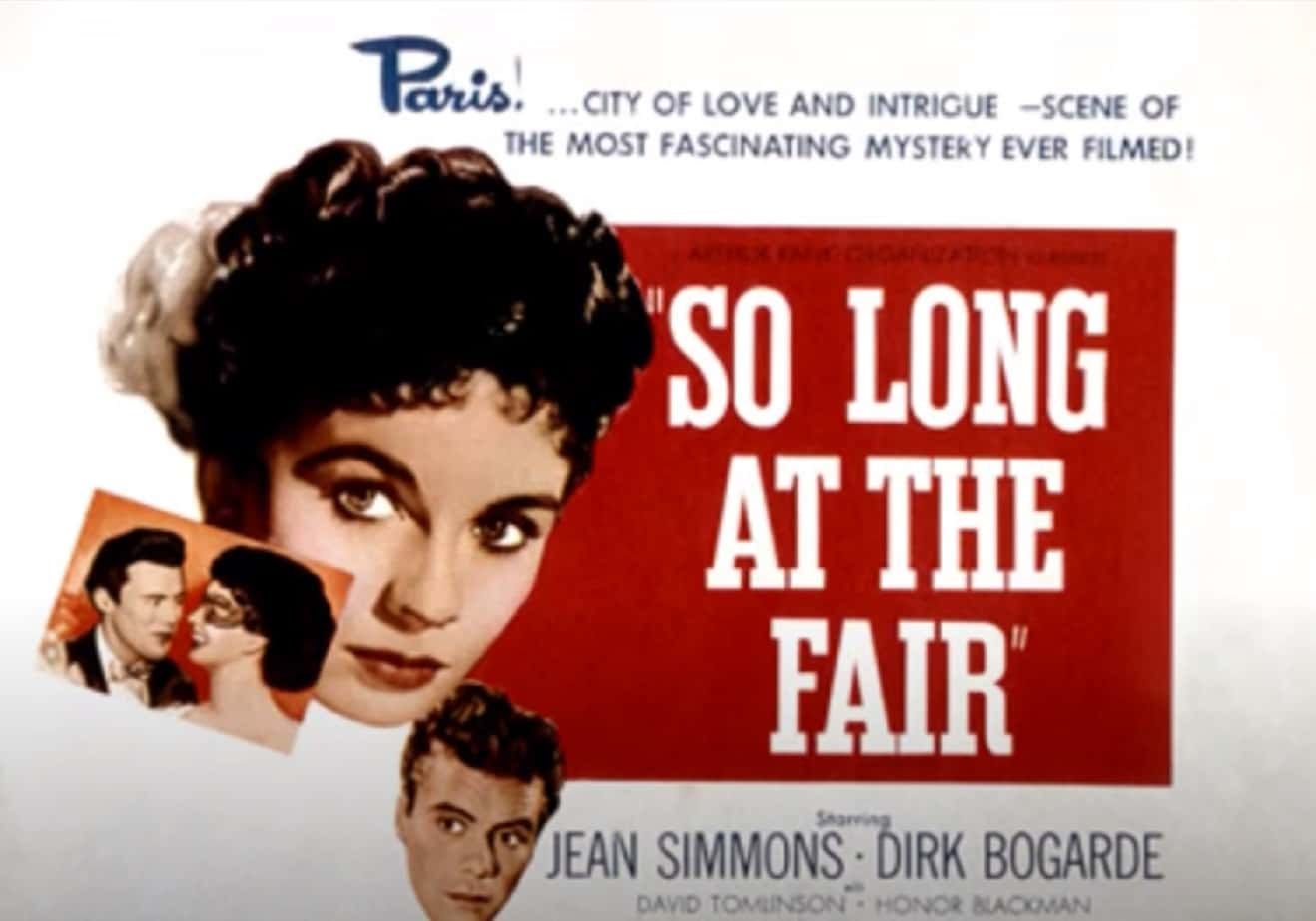 So Long at the Fair(1950), United Artists
So Long at the Fair(1950), United Artists
16. She Was A “Hughes” Deal
Now that she was a full-grown woman—and a massive film star—Jean Simmons began attracting admirers, married or not. One very powerful admirer in particular. After watching Simmons in So Long at the Fair, legendary business magnate Howard Hughes became obsessed with her. The love-crazed magnate bought out her contract from The Rank Organisation. Simmons was in for the shock of her life.
 So Long at the Fair(1950), United Artists
So Long at the Fair(1950), United Artists
17. She Was Going Hollywood
Hughes had purchased Simmons’ contract from The Rank Organisation without her knowledge. She had absolutely no say in the matter. Up to that point, she had only starred in The Rank Organisation’s British productions. Now suddenly, she found herself in the hands of a powerful—and obsessed—Hollywood producer. Everything was about to change—and not necessarily for the better.
 Flickr, UNC Greensboro Special
Flickr, UNC Greensboro Special
18. She Was Headed Stateside
At the same time that Hughes purchased Simmons’ contract, her husband starred in King Solomon’s Mines, making him a Hollywood star. So, the British power couple left London for the City of Stars. Of course, it didn’t take Simmons long to figure out that her old studio had sold her contract to Hughes. And she was about to get too close for comfort.
 So Long at the Fair(1950), United Artists
So Long at the Fair(1950), United Artists
19. Her Husband Was Furiously Jealous
Once Simmons was stateside, Hughes was eager to, how should we put it, “test out” his new purchase. But Granger wasn’t having any of it. In a rage, he called Hughes on the phone and shouted, “Mr. Howard bloody Hughes, you’ll be sorry if you don’t leave my wife alone". Based on what happened next, Hughes must have had the call on mute.
20. She Was Officially A Hollywood Star
Simmons’ first Howard Hughes-produced film was also her American feature film debut. She starred in Androcles and the Lion in 1952 and, for the most part, it sounds like Hughes managed to keep his hands off the merchandise. But that didn’t mean that the love-struck producer couldn’t get someone else to lay hands on Simmons for him...
 Androcles and the Lion (1952), RKO Radio Pictures
Androcles and the Lion (1952), RKO Radio Pictures
21. She Was In Hughes’ Crosshairs
Hughes next had Simmons star in the 1952 film Angel Face. Considering what he had in mind for his new starlet, however, the title of the film was a little ironic. Hughes met with the film’s director, Otto Preminger, and told him, “I’m going to get even with that little [female dog], and you’re going to help me". She didn't know it yet, but Jean Simmons was definitely in danger.
22. She Was On The Edge Of 18
Hughes only had Simmons under contract for 18 more days and he wanted to exact his revenge on her. The lust-crazed producer told Preminger that he would give him a bonus if he managed to film Angel Face in 18 days. Hughes also allowed Preminger to rewrite the script however he pleased. The notoriously cruel Preminger knew exactly what that meant.
23. She Took It On The Chin
A scene in Angel Face saw Robert Mitchum, Simmons’ co-star, smack her across the face. Preminger, famous for being a “bully” of a director, kept ordering retakes of the scene and demanding that Mitchum smack Simmons harder and harder to get the "proper" reaction. Fortunately, for Simmons’ sake, there was one gentleman on set during filming.
24. She Had A Guardian Angel
It was obvious to everyone that Preminger was being cruel to Simmons—though they had no idea it was at Hughes’ behest. Finally, when the devilish director yelled, “Once more!” Mitchum, Simmons’ co-star, spun around and gave Preminger the slap he had been asking for. Preminger fled from the set and demanded Mitchum be fired.
The actor was too big of a star, however, so Preminger had no choice but to slink back to the set and continue filming. He never interfered with Simmons again.
25. She Had The Face Of An Angel
For all of the grief (and bruises) that she received from Preminger on the set of Angel Face, Simmons’ beauty and talent still managed to shine through. The British film critic and historian David Thomson said of her performance, “If she had made only one film—Angel Face—she might now be spoken of with the awe given to Louise Brooks". Unfortunately, she did not only make one film...
 Reviving Old Time Celebrities - Jean Simmons ,Vintage Archives
Reviving Old Time Celebrities - Jean Simmons ,Vintage Archives
26. She Could Have Been On Holiday
Out of sheer spite and pettiness, Hughes might also have held Simmons back from even greater fame and fortune. Director William Wyler wanted to cast Simmons in the lead role in Roman Holiday—the role that turned Audrey Hepburn into a household name. However, Hughes refused to release Simmons from her contract and she missed out on the opportunity of a lifetime.
27. She Was Very Forgiving
Surprisingly, despite the drama on the set of Angel Face and Hughes’ cruelty towards her, Simmons never really held a grudge. Years later, in an interview with The Guardian, the older Simmons said about Hughes, “I guess he had his idiosyncrasies, but I found him very nice—he would almost come into a room backward, he was so shy". Hey, someone has to take the high road.
 Reviving Old Time Celebrities - Jean Simmons ,Vintage Archives
Reviving Old Time Celebrities - Jean Simmons ,Vintage Archives
28. She Was Free At Last
Simmons only managed to free herself from Hughes’ controlling grip by taking him to court. When Hughes realized how serious Simmons was about freeing herself from his contract, however, he agreed to let her go—for a price. Hughes made Simmons appear in a few extra films in exchange for her freedom. But freedom wasn’t all it was cracked up to be.
 Reviving Old Time Celebrities - Jean Simmons ,Vintage Archives
Reviving Old Time Celebrities - Jean Simmons ,Vintage Archives
29. Her Looks Stood In Her Way
Simmons’ beauty had made her a favorite amongst producers—and not just the creepy and obsessive types. But her good looks were too much for some casting directors and co-stars to bear. Once she freed herself from her contractual obligations to Hughes, Simmons found that good roles were hard to come by without the support of powerful producers.
 Reviving Old Time Celebrities - Jean Simmons ,Vintage Archives
Reviving Old Time Celebrities - Jean Simmons ,Vintage Archives
30. She Was Just Too Pretty
Simmons’ first film after her contract with Hughes ended was 1953’s smashing success Young Bess. But she almost didn’t land the role, playing the titular character alongside her husband, Stewart Granger. Yet again, her good looks were actually a problem. Originally, the film’s director thought that she was too pretty to play Elizabeth I. To be fair, she probably was—but she landed the role anyway.
 Reviving Old Time Celebrities - Jean Simmons ,Vintage Archives
Reviving Old Time Celebrities - Jean Simmons ,Vintage Archives
31. She Caused A Stir
Rumor has it that Howard Hughes wasn’t the only man who was powerless against Simmons’ good looks. According to Richard Burton’s biographer, Simmons carried on an affair with the infamously promiscuous actor while on the set of 1953’s The Robe. Whether or not the rumors were true, they spread like wildfire—all the way back to Granger.
 Reviving Old Time Celebrities - Jean Simmons ,Vintage Archives
Reviving Old Time Celebrities - Jean Simmons ,Vintage Archives
32. Her Husband Went Postal
Given the way that Granger had reacted to Hughes’ advances on his wife, it’s no surprise that he drastically overreacted to the news of her affair. Apparently, when Granger heard the stories about his wife and Burton, he confronted the actor with a pistol and warned him to stay away from his wife. Burton heard the message loud and clear.
33. She Had Another Admirer
Simmons’ stunning good looks landed her in trouble once again, this time on the set of 1955’s Guys and Dolls. Despite tensions on set, Simmons got along famously with the film’s director, Joseph L. Mankiewicz. But even she could tell his intentions weren't pure. She recalled years later, “I was aware that he was in love with me, and I think I was with him, really, which I've never admitted to anybody".
34. She Was Not That Nice
For the most part, Simmons got along with her co-stars and fellow filmmakers. Maybe too well, in the cases of Richard Burton and Joseph L. Mankiewicz. But she was also something of a mean girl. On the set of 1954’s The Egyptian, Simmons teased her co-star Bella Darvi who was playing the role of Nefer. She teased that Darvi was “an actress who ‘nefer’ was". Rude!
35. She Was Traumatized
Simmons couldn’t rely on her good looks to carry her through her entire career. The actress claimed that her experience on the set of 1958’s box office success, The Big Country, left her traumatized. Allegedly, the film’s director, William Wyler, kept calling for retakes that left his cast exhausted. And it got worse from there.
36. Her Lines Kept Changing
In an interview she gave decades later, Simmons revealed what left her so traumatized from The Big Country. “We'd have our lines learned,” she recalled, “then receive a rewrite, stay up all night learning the new version, then receive yet another rewrite the following morning. It made the acting damned near impossible".
 Reviving Old Time Celebrities - Jean Simmons ,Vintage Archives
Reviving Old Time Celebrities - Jean Simmons ,Vintage Archives
37. Her Marriage Fell Apart
The trauma from her experience on set must have taken its toll on Simmons’ marriage. Either that or maybe Granger was just tired of fending off his wife’s rich and powerful suitors. In early 1960, Simmons and Granger finally decided to call it quits and got a divorce. But Simmons didn’t waste any time moping around and feeling sorry for herself. She'd never struggled to find male attention before, and now that she was single...
38. She Had One Last Fling
Simmons began production on Richard Brooks' 1960 film Elmer Gantry during her divorce from Granger. In fact, this film might be the reason that Simmons broke it off with her husband of ten years. From the looks of it, Simmons and Brooks sparked a romance of their own before Simmons actually finalized her divorce.
 Reviving Old Time Celebrities - Jean Simmons ,Vintage Archives
Reviving Old Time Celebrities - Jean Simmons ,Vintage Archives
39. She Fell In Love Again
By December of that same year, Simmons walked down the aisle once again. This time, it was Richard Brooks waiting for her at the altar. Not that long after, Simmons gave birth to a beautiful baby girl. Considering how quickly she moved on—and consummated her new marriage—rumors that she began her affair with Brooks while still married to Granger sound a lot more plausible.
40. She Got Milk
Brooks clearly had a way with Simmons. During a pyrotechnics scene in Elmer Gantry, Simmons became so alarmed at the inferno around her that she fled the set. Brooks managed to calm her frayed nerves...by plying her with five spiked glasses of milk. Simmons returned to set—but potentially picked up a bad habit in the process.
 Reviving Old Time Celebrities - Jean Simmons ,Vintage Archives
Reviving Old Time Celebrities - Jean Simmons ,Vintage Archives
41. She Would Have Done Anything To Get Off
Simmons continued to experience grueling challenges on her film sets. Famously, she had a difficult time on the set of 1960’s Spartacus. Allegedly, co-star Tony Curtis jokingly asked her, “Who do I have to [sleep with] to get off this film?” Simmons quipped back, “When you find out, let me know". She was only half joking.
42. She Bared It All
Trying to find someone on set to sleep with should have been easy for Simmons. The jaw-dropping beauty had to spend hours upon hours on set completely shirtless for Spartacus. It was for a sensual scene in a pond where the water level had to be just right. The actress had nothing but some tiny band-aids to cover up her more intimate parts. She was a long way from Ophelia...
 Reviving Old Time Celebrities - Jean Simmons ,Vintage Archives
Reviving Old Time Celebrities - Jean Simmons ,Vintage Archives
43. She Started Drinking
Throughout the 1960s, Simmons’ opportunities started drying up. Ironically, it might have been because she had developed a taste for the “wet bar". The rumor around the Hollywood water cooler was that Simmons was drinking more than she should—and it wasn’t water or orange juice. Sadly, the rumors turned out to be quite true.
 Reviving Old Time Celebrities - Jean Simmons ,Vintage Archives
Reviving Old Time Celebrities - Jean Simmons ,Vintage Archives
44. She Was Just Playing Pretend
Simmons’ husband Richard Brooks cast the aging beauty in 1969’s The Happy Ending. In the film, Simmons’ character struggles with addiction. According to Simmons herself, Brooks wrote the character based on her in the hopes that acting out her inner turmoil might help her recover. It would take more than a few lines, however, for her to drop the bottle.
45. She Had A Bright Future Ahead
After the 1970s, Simmons’ career was on the decline. She stopped appearing in big-budget productions with top billing and started making minor TV appearances. Little did she know, however, that the best times of her career were still ahead of her. She was aging like the graceful beauty that she was, and true success was just around the corner.
 Reviving Old Time Celebrities - Jean Simmons ,Vintage Archives
Reviving Old Time Celebrities - Jean Simmons ,Vintage Archives
46. She Was On The Mend
There was no happy ending for Simmons and Brooks. After 20 long years of marriage, the couple separated in 1977 and officially divorced three years later. Knowing that she had a problem with the bottle, Simmons opened up about her addiction and checked herself into rehab. After all, she had a comeback to make.
 Reviving Old Time Celebrities - Jean Simmons ,Vintage Archives
Reviving Old Time Celebrities - Jean Simmons ,Vintage Archives
47. She Received Her Crowning Moment
Once she recovered from her addiction, Simmons returned to acting. She finally took Laurence Olivier’s advice and performed on the stage. Clearly, she learned something from her time with theater thespians. In 1985, Simmons won a Primetime Emmy Award for her role in the miniseries The Thorn Birds. It was the recognition she had finally earned.
 Reviving Old Time Celebrities - Jean Simmons ,Vintage Archives
Reviving Old Time Celebrities - Jean Simmons ,Vintage Archives
48. She Aged Gracefully
Simmons changed her philosophy on the acting business following her Emmy win. She used to base her success on her looks but that changed. She said, “Every actress has to face the facts. There are younger, more beautiful girls right behind you. Once you've gone beyond the vanity of the business, you'll take on the tough roles".
 Reviving Old Time Celebrities - Jean Simmons ,Vintage Archives
Reviving Old Time Celebrities - Jean Simmons ,Vintage Archives
49. She Might Have Been Clingy
Both of Simmons’ husbands—Granger and Brooks—were significantly older than she was. It led many to speculate that the actress had unresolved father issues. In her older age, Simmons reflected, “Most people thought I was quite helpless—a clinger and a butterfly—during my first marriage". But nothing could have been further from the truth.
 Reviving Old Time Celebrities - Jean Simmons ,Vintage Archives
Reviving Old Time Celebrities - Jean Simmons ,Vintage Archives
50. She Lived Each Day To The Fullest
Simmons learned something from her two failed marriages. In an interview years after her last divorce, Simmons recalled some advice that her second husband had given her. “Never be afraid to fail,” Brooks told her. “Every time you get up in the morning, you are ahead". That’s a philosophy that Simmons took to heart right to the very end.
 Reviving Old Time Celebrities - Jean Simmons ,Vintage Archives
Reviving Old Time Celebrities - Jean Simmons ,Vintage Archives
51. She Had A Wonderful Run
Few actresses ever have the kind of success that Simmons had. Her natural beauty definitely had a role to play in her success—and her failures. But her accomplishments were all her own. She said, “My career has had a lot of ups and downs, but basically it has been wonderful". Of course, that’s easy to say if you’re a British beauty.
 Reviving Old Time Celebrities - Jean Simmons ,Vintage Archives
Reviving Old Time Celebrities - Jean Simmons ,Vintage Archives
Sources: 1, 2, 3, 4, 5, 6, 7, 8, 9, 10, 11, 12, 13, 14, 15, 16, 17, 18, 19, 20, 21, 22, 23



